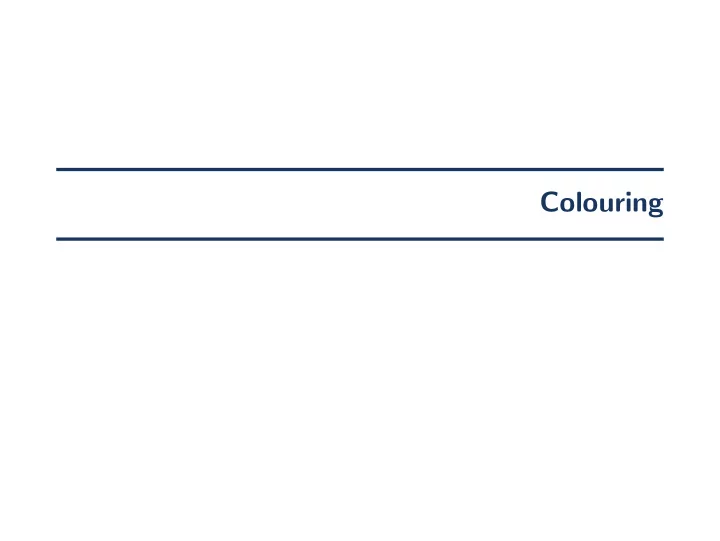

Colouring
Colouring Colouring For a graph G = ( V , E ) , a colouring is a function c : V → N such that uv ∈ E implies c ( u ) � = c ( v ) . A graph is k -colourable if there is a colouring c which uses at most k colours, i. e., c : V → { 1 , . . . , k } . 2 / 7
Colouring The k -Colouring problem asks, for a given graph, it is k -colourable. Theorem There is (probably) no polynomial time algorithm to determine if a given graph is k -colourable for all k ≥ 3 . Some observations ◮ G is k -colourable if and only if each block of G is k -colourable. ◮ If G has a clique of size k , a colouring for G requires at least k colours. 3 / 7
Colouring Theorem The 2-colouring problem can be solved in linear time. 2-Colouring Algorithm ◮ Pick an arbitrary vertex v . ◮ Run a BFS starting in v . ◮ For all vertices u in even distance to v , set c ( u ) := 1 . For all vertices u in odd distance to v , set c ( u ) := 2 . ◮ If there is an edge uw with c ( u ) = c ( w ) , then G is not 2-colourable. Graphs which are 2-colourable, are also called bipartite. 4 / 7
Colouring Planar Graphs
Colouring Planar Graphs Recall: Theorem For a connected planar graph G = ( V , E ) with at least three vertices, | E | ≤ 3 | V | − 6 . Therefore: Theorem Each planar graph contains a vertex with degree at most 5. Proof. By pigeon-hole principle. � Thus, there is a vertex order � v 1 , v 2 , . . . , v n � such that v i has degree at most 5 in G i = G [ { v i , v i + 1 , . . . , v n } ] . 6 / 7
Colouring Planar Graphs Input : A planar graph G . Output : A colouring c : V → N + . 1 Find a vertex order � v 1 , v 2 , . . . , v n � such that v i has degree at most 5 in G i . 2 For i := n downto 1 Assign c ( v i ) the lowest available colour greater or equal to 1 . 3 Theorem There is a linear time algorithm to find a 5-colouring and an O ( n 2 ) time algorithm to find a 4-colouring for planar graphs. There is (probably) no polynomial time algorithm to find a 3-colouring for a planar graph, even it is known that such a colouring exist. 7 / 7
Recommend
More recommend